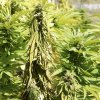King Dude
Active Member
The insects may feed on living plants, but they'll hide under leaf litter. Fusarium grows on the decaying plant matter, which has spores that can be shuttled from the soil surface by the insects that travel between the litter and the living plant.Not a bad idea to compost it a little before using it. Insects that are harmful to cannabis growers tend to be those that feed on living material, they aren't going to stick around on dead vegetation. Even the eggs, spider mite eggs only take about 3 days to hatch. Same with fungus, the fungi that break down dead material are not the same species that cause harm to living pot plants.
This picture is an example of what fusarium does to cannabis. It may look familiar to anyone that has ever experienced "damping off".

